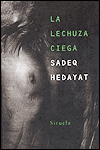El búho ciego, de Sadeq Hedayat

Han caído en mis manos, por una de esas casualidades que tiene la vida y que hacen a uno pensar que los libros nos eligen a nosotros y no viceversa, han caído, digo, unas fotocopias de El búho ciego (Buf-e kur) del iraní Sadegh Hedayat aparecidas hace 30 años en el "Anuario de filología" (1975, número 1, pp 135-192), aunque publicadas en persa en 1941. Esta obra también la han editado recientemente en español Siruela e Hiperión.
Jamás pensé que hace 70 años alguien pudiera escribir en Irán lo que se narra en esta novela. Pero más sorprende, si cabe, la manera de maestro titiritero en que Hedayat mueve el alma de su protagonista, drogado y muerto, transladándole de la locura a la razón sin solución de continuidad ayudado de una simbología que despertaría las envidias de Antonio y Manuel Machado, Rimbaud, Verlaine y Baudelaire. No en vano, este autor anhelaba París, ciudad a la que soñaban ir todos los simbolistas españoles e hispanoamericanos cuando era la época dorada de esta corriente literaria, a la que Hedayat se apuntó tarde, razón ésta por la que, quizá, acabaría suicidándose en la Ciudad de las Luces.
Cuando se escribió esta obra estaba de moda Freud y el psicoanálisis, pero aquí el autor, a pesar de ser una obra plenamente edípica, va mucho más allá de ello. Se aproxima a la psicología de Jung, cuando todavía no era muy conocido, donde los arquetipos (la virgen, la madre, la amante...) y el inconsciente colectivo (que Hedayat describe como "la canalla") afloran una y otra vez desde el subconsciente del protagonista para provocar en el lector un tumulto debido a que el autor es capaz de mover la cámara de tinta por los entresijos del cerebro del personaje, llegando a ofrecernos destellos imposibles de captar del consciente, del preconsciente y del inconsciente.
No creo que Hedayat haya sido capaz de contestar en este relato a la pregunta "¿qué experimentarán los muertos que se dan cuenta de que han fallecido?", pero eso es lo de menos. La forma, como en toda narración simbólica o modernista, prima, en mi opinión, sobre el fondo.
No ha podido haber mejor lectura para este primer día del año persa. Por cierto, si les gusta este poema de Allan Poe deberían leer el libro.
3 comentarios
zara -
One of the distinctive features of The Blind Owl (pub.1937)is its kinship with European Modernist prose of the early twentieth century- a body of literature which bares witness to the fascination of innovative writers from that period with psychoanalysis. The paper proposes that the writer of The Blind Owl does not merely \\\'borrow\\\' from his Western counterparts ready-made motifs and allusions pertaining to sexual angst and the unconscous. It suggests, instead that Hedayat attemps a radical \\\'recasting\\\' of Persian tradition itself, channeling recurrent conventonal images and themes of the clasical legacy into the paradigms of psychological affliction, shared by modernist writings from the first half of the twentieth century.
By Matra Simidchieva
(York University,2003 )
zara -
The anti-heroes long for the angel who is beyond their reach, and dtest the harlot, who seems to be the only available alternative. Thus there is no successful love or love-making in the psycho-fiction. In Hedayats critical realist fiction, on the other hand, the portrayal of both men and women is normal and realistic. The critical realistic works are about the lives of ordinary traditional townsfolk, whereas the psycho-fiction portray people of the authors own class and culture, the modern middle class and above.
By :Homa Katouzian ( University of Oxford, 2003 )
*angel
**slut
Anónimo -
*******
Informed by European fascism, racial and linguist purity were the key elements of the Iranian national and cultural revivalism of the 1920s and 1930s. The enthusiasm for the renewal of ancient glory was coupled with anti-Arab zealotry, a distinctly Iranian for of ant-Semitism. The nostalgia for a pure pre-Islamic/pre-Arab past informed the literary, historical, and political imaginaries of those decades. The early works of Sadeq Hedayat were exemplars of such nostalgic romanticism that sought to recover Irans assumed Aryan purity by attributing all impurities to the Semite Arabs.
By:Mohammad Tavakoli-Tareghi ( University of Toronto,2003 )